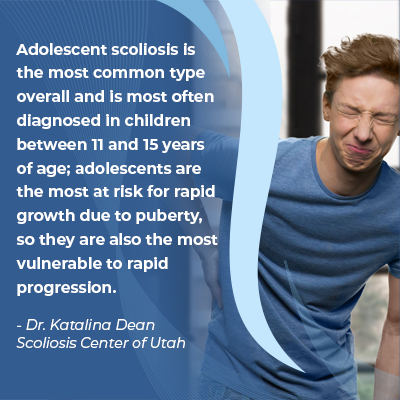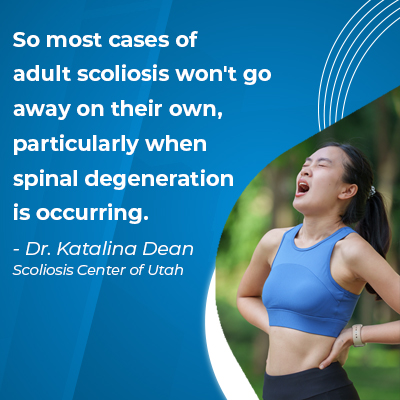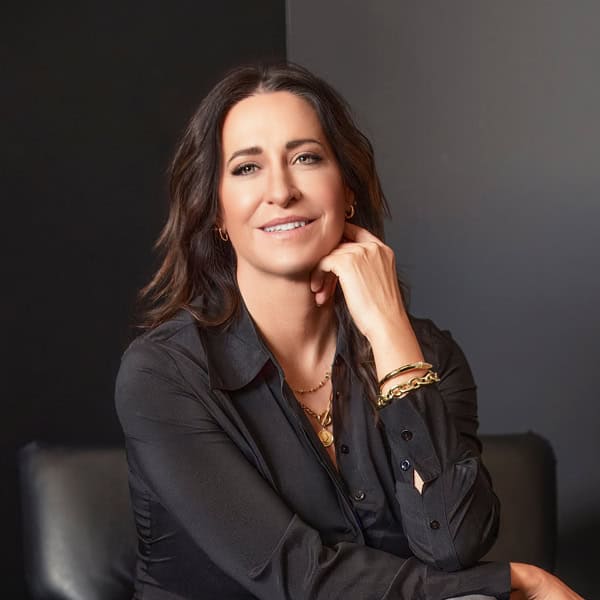Blogs
Does Scoliosis Go Away on Its Own? What to Expect

As there is no way to predict, with 100-percent accuracy, which cases of scoliosis will stabilize and which will progress with growth and time, it’s important to approach treatment with the goal of counteracting the condition’s progressive nature.
While some cases of early-onset scoliosis can resolve on their own, most cases of scoliosis are progressive. The nature of scoliosis is to get more severe over time, so most cases will get worse at some point, and this is why a proactive treatment approach can be so beneficial.
As most cases of scoliosis don’t simply go away on their own, let’s talk about what makes scoliosis progress and what progression looks and feels like.
Scoliosis is a Progressive Spinal Condition
Scoliosis is a progressive spinal condition that causes the spine to develop an unnatural lateral curvature that also twists; the spine’s rotation makes the condition 3-dimensional, and it needs to be addressed as such by treatment.
Scoliosis makes the spine unstable and unbalanced, and it can affect the entire body from postural changes to movement disruptions and pain.
If scoliosis is left untreated, it can develop complications that affect quality of life, but when caught and treated early, it can be highly responsive.
Scoliosis progression means the condition is becoming more severe, and this is evident by the size of the unnatural spinal curve increasing and condition effects becoming more pronounced.
In children, progression can occur quickly because it’s triggered by growth, so the more growth a young scoliosis patient has to go through prior to reaching skeletal maturity can mean more potential progression.
Childhood Scoliosis Progression
Scoliosis can affect all ages from babies born with congenital scoliosis to infantile scoliosis, early-onset juvenile scoliosis, and adolescent idiopathic scoliosis.
 Adolescent scoliosis is the most common type overall and is most often diagnosed in children between 11 and 15 years of age; adolescents are the most at risk for rapid growth due to puberty, so they are also the most vulnerable to rapid progression.
Adolescent scoliosis is the most common type overall and is most often diagnosed in children between 11 and 15 years of age; adolescents are the most at risk for rapid growth due to puberty, so they are also the most vulnerable to rapid progression.
Congenital scoliosis is caused by the spine not forming properly in utero, and a malformed spine won’t simply go away.
Cases of infantile scoliosis are diagnosed in infants under 3 years of age, and these cases are the most likely condition type to resolve on their own, but there is no way of determining which will resolve and which will progress with growth, so proactive treatment is recommended.
When it comes to juvenile scoliosis diagnosed between the ages of 3 and 9, a big impact can be made with treatment because the first significant pubescent growth spurt, and its related progression, hasn’t occurred yet.
So in most cases of scoliosis, particularly childhood scoliosis that can progress as a child grows, the sooner treatment is started, the more successful nonsurgical treatment is likely to be.
But as a progressive condition, treating scoliosis means treating a condition that’s ongoing; whether it progresses and progresses slowly or quickly will depend on a number of factors, but few cases of childhood scoliosis will resolve on their own.
Adult Scoliosis Progression
Scoliosis is more commonly diagnosed in children, but it also affects adults of all ages. The two main types of scoliosis diagnosed in adults are adolescent scoliosis in adults (ASA) and degenerative scoliosis.
Adolescent idiopathic scoliosis is the condition’s most common type, and when it develops, but is not diagnosed or untreated during adolescence, it can progress with time and gravity into adulthood, when it becomes compressive and more noticeable.
Compression is the main cause of scoliosis pain, and this can involve the spine’s surrounding muscles, back pain, and nerve pain.
So as scoliosis gets worse, so does related pain.
Some cases of adolescent scoliosis in adults are stable, but most progress with age.
Degenerative Scoliosis
Adult scoliosis tends to progress slower because skeletal maturity has been reached, but if age-related spinal degeneration becomes a factor, as it can with older adults, the spine can become increasingly unbalanced and unstable, and this places older adults at risk for serious falls and injury.
Degenerative scoliosis affects more than 30 percent of adults over the age of 60 and 50 percent of adults over 90.
Older adults are likely experiencing joint and disc degeneration that can make their spine weaker, unstable, and misaligned.
Because spinal degeneration is a factor, most cases of degenerative scoliosis are progressive.
Symptoms of adult scoliosis can include poor posture, back pain, hip pain, balance issues, loss of height, and excessive spinal degeneration due to the uneven forces of scoliosis.
 So most cases of adult scoliosis won’t go away on their own, particularly when spinal degeneration is occurring.
So most cases of adult scoliosis won’t go away on their own, particularly when spinal degeneration is occurring.
What to Expect From Scoliosis Treatment
As a progressive spinal condition triggered by growth, scoliosis won’t simply go away on its own; it needs proactive treatment options capable of impacting conditions on a structural level.
Because the vast majority of scoliosis cases are progressive, treatment is about addressing a fluctuating condition so has to be ongoing.
What to expect from treatment varies based on the treatment approach in question.
Patients generally have two main choices: to address scoliosis with surgery or nonsurgical treatment. Here at the Scoliosis Center of Utah, patients benefit from a proactive individualized conservative approach to scoliosis treatment.
Scoliosis surgery is a type of spinal fusion, and treating scoliosis with surgery can mean a weaker and less flexible spine, and in addition, the risks of infection and nerve damage come with the procedure.
Treatment options for scoliosis that don’t involve surgical intervention are more natural, less invasive, and better for the spine’s long-term strength and health.
Through an innovative combination of Chiropractic BioPhysics®, scoliosis exercises, and corrective bracing, 3-dimensional correction may be possible, and the sooner treatment is started, the more likely it is that the spine will respond well.
The Chiropractic BioPhysics® Advantage
Chiropractic Biophysics® (CBP) represents the apex of chiropractic care; it combines biology, physiology, physics, geometry, and anatomy to identify the cause of back and joint pain, instability, mobility changes, and a number of health problems.
Only one percent of the world’s chiropractors are certified in CBP, and many patients of the Center benefit from its application.
Through manual adjustments and a number of techniques, the spine’s vertebrae can be adjusted and the spine’s alignment improved: restoring its healthy curves, balance, and stability.
ScoliBalance® Therapy
ScoliBalance® therapy is a complete approach to addressing scoliosis through combining the treatment of therapists, physical therapy, and chiropractic.
By designing a custom exercise program that addresses the specific curvature type, body type, and posture of a patient, ScoliBalance® can help manage progression, reduce the size of scoliosis curves, improve a patient’s balance, muscular balance, strengthen the spine’s surrounding muscles, improve the spine’s flexibility, body posture and appearance.
Mirror-image exercises are commonly used to teach patients postural awareness and remodeling and to sustain treatment results.
The ScoliBrace® Solution
The ScoliBrace® is modern and innovative and combines what treatment providers have learned about brace efficacy over the years.
As the spine’s rotation makes scoliosis a 3-dimensional condition, treatment needs to address it as such, and a 3-dimensional corrective scoliosis brace can help push the spine into a healthier position and alignment.
There are never treatment guarantees, and due to the complexity of scoliosis, no one form of treatment is enough to correct scoliosis, but the best way to minimize its symptoms is to treat it with a multifaceted approach.
Conclusion
So does scoliosis go away? Not exactly. While some cases can be stable and not get worse over time, most cases of scoliosis worsen with growth, time, and degeneration.
As a progressive condition, scoliosis is ongoing, and conservative scoliosis treatment options strive to reduce the curve size, manage progression, and re-balance and align the spine; this will improve the entire body’s symmetry.
While spinal fusion surgery can straighten the spine by fusing its most-tilted vertebrae together into one solid bone, this can also mean a spine that’s more vulnerable to injury and less flexible.
Scoliosis screening can help with early detection and treatment which has a number of benefits; the longer scoliosis is left untreated, the more work it will take to correct.
Scoliosis screening is recommended for all children, but particularly when the risk factors of gender, age, and family history are in place.
As conditions can range from mild curves to moderate scoliosis and severe cases, like neuromuscular scoliosis, a scoliosis diagnosis means treatment should be started as soon as possible for the best potential nonsurgical results.

Dr. Katalina Dean
Dr. Katalina Dean is the founder and clinical director of Scoliosis Center of Utah, in Midvale, UT. Her team specializes in posture correction, spinal rehabilitation, and non-invasive scoliosis care and bracing.
Call Today
Do You Qualify for Care?
Schedule an Appointment Below
